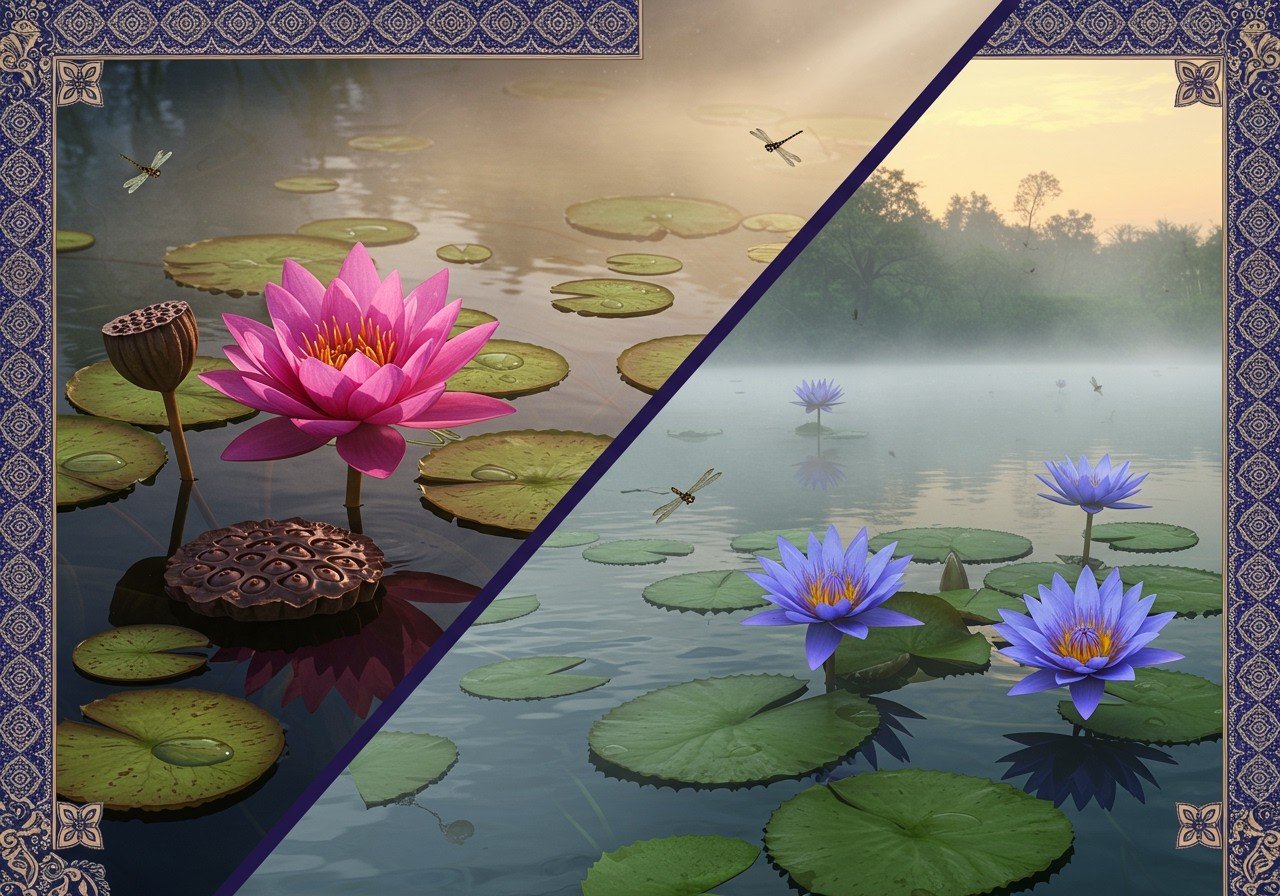
The Sacred Lotus and Blue Lotus hold profound cultural and spiritual significance, especially in India. For those seeking authenticity in rituals and ceremonies, understanding the distinctions between these two remarkable aquatic plants is essential. Let’s explore the unique characteristics of Nelumbo Nucifera, the Sacred Lotus, and Nymphaea Caerulea, the Blue Lotus.
Distinguishing Features: A Closer Look
Recognizing the differences between the Sacred Lotus and the Blue Lotus begins with understanding their distinct botanical characteristics. Here’s a detailed comparison to guide you:
- Leaves: The Sacred Lotus displays large, circular leaves that rise majestically above the water, creating a stunning visual. These leaves are unbroken, without any notches. In contrast, Blue Lotus leaves float on the water’s surface and have a noticeable V-shaped notch. Also, Sacred Lotus leaves are thin, almost papery to the touch, while Blue Lotus leaves have a thicker, waxy texture. Think of the lotus leaf as a pedestal, lifting the flower towards the heavens.
- Flowers: The Sacred Lotus flower, often larger and more imposing, stands tall above the water, a symbol of purity and enlightenment. The Blue Lotus flower, smaller and more delicate in appearance, rests directly on the water’s surface, radiating tranquility. The petals of the Sacred Lotus tend to be rounded or slightly ruffled, adding to its majestic presence, while Blue Lotus petals have a distinct pointed shape, giving the bloom a star-like appearance. The flowers are the soul of these plants, each with its own unique charm.
- Coloration: The Sacred Lotus exhibits a uniform green on its leaves, with vibrant colors reserved for its blossoms. The Blue Lotus often showcases a striking contrast, with leaves that can be green, mottled with white, or even tinged with purple. These variations add to the allure of the Blue Lotus.
- Habitat and Hardiness: While both thrive in aquatic environments, their preferences differ. Blue Water Lilies are generally hardier, adaptable to zones 4-11. Sacred Lotuses prefer warmer climates, thriving in zones 5 and further south. In terms of water depth, water lilies can flourish in depths of 2-5 feet, while lotuses favor shallower waters of around 12 inches. These subtle differences highlight their unique adaptations.
- Seeds: The Sacred Lotus seeds mature above the water surface and are eventually released to float away, carrying the promise of new life. Blue Lotus seeds, on the other hand, begin above the water but then submerge to ripen before being released to sink and take root in the depths. These contrasting journeys of life and renewal speak to their diverse natures.
- Other Differences: The fragrance of the Sacred Lotus is subtle and ethereal, while the Blue Lotus emits a stronger, sweeter perfume, especially during its initial bloom. When it comes to nourishment, lotuses generally require more fertilizer than water lilies, reflecting their robust growth. And while the beautiful blooms of a water lily may last up to two weeks before gracefully fading beneath the surface, the lotus offers a lasting presence with its distinctive seed pod that continues to grow skyward even after the flower is gone. These nuances add depth to our appreciation of these extraordinary plants.
- Botanical Family: The Sacred Lotus (Nelumbo nucifera) belongs to the Nelumbonaceae family, while the Blue Lotus (Nymphaea caerulea) is a member of the Nymphaeaceae family. This distinction underscores their fundamental differences.
Cultural Significance and Symbolism
In India, the Sacred Lotus holds immense cultural significance. It’s a potent symbol of purity, enlightenment, and rebirth, deeply intertwined with Hindu and Buddhist philosophies. Picture the serene beauty of a lotus flower emerging from a temple pond, a visual representation of spiritual awakening.
The Blue Lotus, while not as prominent in Indian tradition, is revered in ancient Egyptian culture for its association with the sun and rebirth, playing a vital role in their rituals and art.
Poojn.in: Your Source for Sacred Ritual Items
At Poojn.in, we understand the importance of using authentic ingredients in your spiritual practices. We offer a wide selection of sacred items, including Pure Ashtagandha Kumkum Tilak , perfect for your daily puja or special ceremonies. We also offer a variety of Brass Doob Grass (Durva) for offerings and other puja essentials.
Explore our complete range of pooja samagri and discover everything you need to create a sacred space in your home. Our commitment to quality and authenticity ensures you receive only the best for your spiritual practices.
Embrace the Beauty and Significance
Whether you’re drawn to the Sacred Lotus for its spiritual symbolism or captivated by the Blue Lotus’s historical significance, these aquatic wonders offer a glimpse into the rich tapestry of human culture and our connection to the natural world. Let their beauty inspire reverence and a deeper appreciation for the traditions they represent.
Learn more about the significance of plants in Hindu rituals in our blog post on Sacred Hindu Plants: Symbolism and Puja Rituals. And if you’re fascinated by the architectural marvels that house these sacred symbols, explore our blog about Chhattisgarh Temples: Architectural Wonders and Spiritual Significance.


